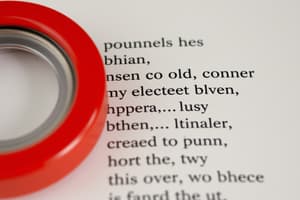Podcast
Questions and Answers
Which of the following is an example of a possessive pronoun?
Which of the following is an example of a possessive pronoun?
- he
- hers (correct)
- who
- they
What is the role of reflexive pronouns in a sentence?
What is the role of reflexive pronouns in a sentence?
- They replace nouns in questions.
- They introduce relative clauses.
- They indicate ownership.
- They refer back to the subject of the verb. (correct)
Which of the following pronouns is used to ask a question?
Which of the following pronouns is used to ask a question?
- these
- some
- who (correct)
- itself
What is a common error regarding pronouns?
What is a common error regarding pronouns?
What do demonstrative pronouns do in a sentence?
What do demonstrative pronouns do in a sentence?
Flashcards are hidden until you start studying
Study Notes
Overview of Pronouns
- Pronouns are words that replace nouns or noun phrases to avoid repetition.
- They help in referring to people, objects, or concepts in a concise manner.
Types of Pronouns
-
Personal Pronouns
- Refer to specific people or things.
- Subjective (e.g., I, you, he, she, it, we, they).
- Objective (e.g., me, you, him, her, it, us, them).
-
Possessive Pronouns
- Indicate ownership or possession.
- (e.g., mine, yours, his, hers, its, ours, theirs).
-
Reflexive Pronouns
- Refer back to the subject of the verb.
- Formed by adding “-self” or “-selves” (e.g., myself, yourself, himself, herself, itself, ourselves, yourselves, themselves).
-
Demonstrative Pronouns
- Point to specific things or people.
- (e.g., this, that, these, those).
-
Interrogative Pronouns
- Used to ask questions.
- (e.g., who, whom, whose, what, which).
-
Relative Pronouns
- Introduce relative clauses and relate to a noun mentioned earlier.
- (e.g., who, whom, whose, which, that).
-
Indefinite Pronouns
- Refer to non-specific people or things.
- (e.g., anyone, everyone, someone, nobody, all, some, many).
Usage Rules
- Pronouns must agree in number and gender with the nouns they replace.
- They should be clear to avoid ambiguity.
Common Errors
- Misusing subjective and objective forms (e.g., "I saw her" vs. "Me saw she").
- Confusing possessive pronouns with contractions (e.g., "its" vs. "it's").
- Lack of pronoun antecedent clarity (ensure pronouns clearly relate to their nouns).
Tips for Clarity
- Ensure pronouns have clear antecedents.
- Rephrase sentences to avoid misinterpretation.
- Use pronouns appropriately to maintain fluid writing.
Pronoun Basics
- Pronouns are words that replace nouns, avoiding repetition and making writing concise.
- They refer to people, objects, or concepts.
Types of Pronouns
- Personal Pronouns: Refer to specific individuals or things.
- Subjective: Used as subjects of verbs (e.g., "I" am going, "he" is eating).
- Objective: Used as objects of verbs or prepositions (e.g., She saw "me", "them" are coming).
- Possessive Pronouns: Indicate ownership (e.g., "Mine" is the blue one, "hers" is red).
- Reflexive Pronouns: Reflect back to the subject (e.g., "I" hurt "myself", "They" enjoy "themselves").
- Demonstrative Pronouns: Point out specific items (e.g., "This" is my favorite, "Those" are old).
- Interrogative Pronouns: Used to ask questions (e.g., "Who" is coming? "What" do you want?).
- Relative Pronouns: Connect relative clauses to nouns (e.g., The book "which" you gave me, The man "who" called).
- Indefinite Pronouns: Refer to nonspecific people or things (e.g., "Someone" is knocking, "Everybody" is happy).
Pronoun Usage Rules
- Pronouns need to match the nouns they replace in number (singular/plural) and gender (masculine/feminine).
- Pronoun use must be clear to avoid confusion.
Common Pronoun Errors
- Using incorrect subjective or objective pronoun forms (e.g., "I saw her" is correct, but "Me saw she" is not).
- Confusing possessive pronouns with contractions (e.g., "its" means belonging to it, "it's" is a contraction of "it is").
- Lack of clear pronoun antecedents (the noun the pronoun refers to): Make sure the connection between a pronoun and its noun is easily understood.
Tips for Clear Pronoun Use
- Ensure every pronoun has a clear antecedent.
- If there is ambiguity, rephrase the sentence to make the meaning obvious.
- Use pronouns strategically to maintain smooth and fluid writing.
Studying That Suits You
Use AI to generate personalized quizzes and flashcards to suit your learning preferences.



